
Since the launch of Vision Zero more than two years ago, NYPD has yet to develop a comprehensive strategy to target dangerous driver behaviors that are known to cause most injuries and deaths. To the contrary, a new Transportation Alternatives report finds that NYPD enforcement often targets the people most vulnerable to traffic violence, while motorist violations like speeding, failure to yield, and even leaving the scene of a crash go unchecked.
"Death, Danger and Ignoring the Data: How the NYPD is Getting Vision Zero Wrong" [PDF] notes that injuries to pedestrians and cyclists increased by 11 percent the first five months of this year relative to the same time frame in 2015. While there was a slight decline in the number of people killed by drivers while walking, cyclist deaths more than doubled.
TA says scattershot traffic enforcement is a big part of the problem.
"The NYPD is falling short on its commitment to consistent, appropriate policing to deter the most deadly driving violations,” said TA Executive Director Paul Steely White in a statement accompanying the report. "Commissioner Bratton and other top police officials don’t even seem to have a clear plan for participation in Vision Zero, and their allocation of traffic enforcement resources does not appear to be based on actual conditions on New York City streets."
Though the majority of cyclists who lost their lives this year were killed by drivers breaking traffic laws, NYPD tends to respond to cyclist fatalities by cracking down on cyclists and publicly blaming victims for their own deaths. This approach epitomizes the department's failure to direct resources toward enforcement that would actually save lives, says TA.
In addition, enforcement priorities vary widely from precinct to precinct. While some precincts have stepped up enforcement against speeding and failure to yield, others are issuing fewer such tickets this year than in 2015, the report says.
TA found there are eight precincts where cyclists are more likely to receive a criminal court summons -- which can lead to jail time and barriers to employment -- than a moving violation for riding on the sidewalk. In the apparent absence of guidance from department brass, precinct COs are free to aggressively target relatively low-risk cycling offenses as motorists kill people in crosswalks.
Other findings from the report:
- Between January and May of this year, officers in 32 precincts issued more tickets for tinted windows than speeding and failure to yield combined
- About a third of pedestrian deaths this year were caused by drivers who failed to yield, but the Right of Way Law, adopted in 2014, “is still being applied infrequently and inconsistently"
- Fatal hit-and-runs are up, with 22 through May compared to 15 during the first five months of 2015
- Just 2.5 percent of hit-and-run crashes in 2015 resulted in NYPD action to hold drivers accountable; NYPD keeps a tight lid on information about hit-and-run cases, despite a law that requires the department to provide data to the City Council
“If 35,000 hit-and-run incidents per year are going completely unenforced, what message does that send to the city’s most dangerous drivers?” said White.
TA says the "Bicycle Safe Passage" initiative -- periods of targeted enforcement against drivers who put cyclists at risk -- should be standard practice at NYPD. White recommends the department "develop a framework for data-driven enforcement and demonstrate a cohesive, clear Vision Zero policy."
“When drivers believe that they are likely to face consequences for unsafe actions, they change their behavior, and the result is safer streets," White said. "Consistent, predictable enforcement is most likely to have the deterrent effect that changes behavior and saves lives.”





